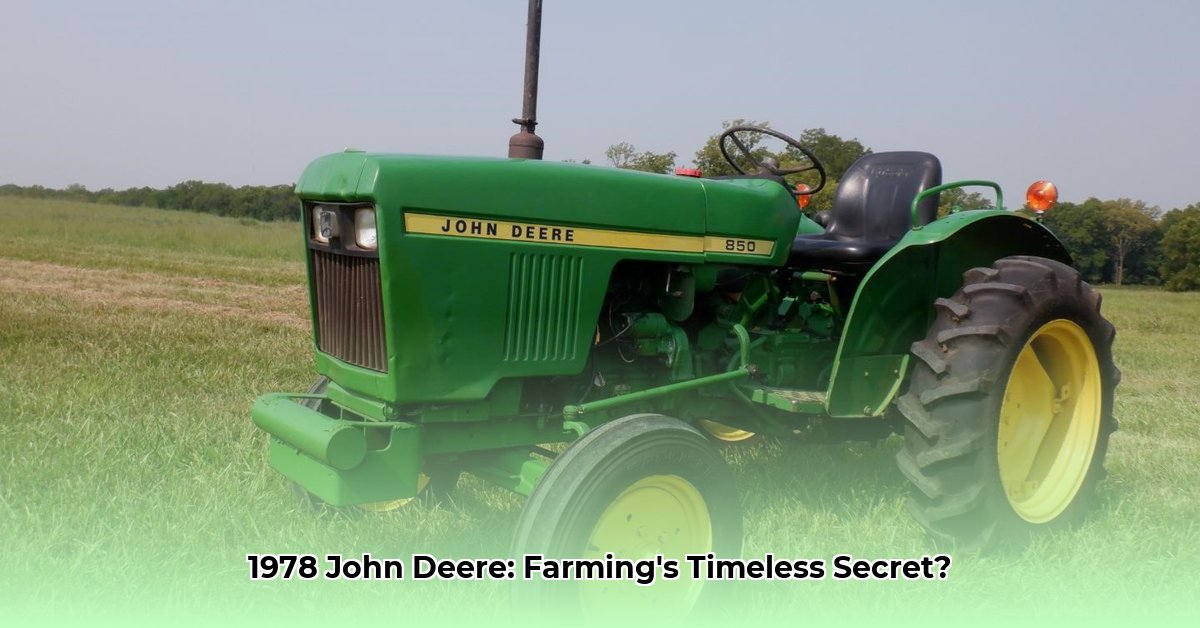
Farming is changing, and so are the tools of the trade. Rising costs and environmental concerns are prompting a renewed interest in vintage farm equipment, including the trusty 1978 John Deere. This isn't just nostalgia; it's a pragmatic approach to sustainable agriculture. This guide explores the practicalities and sustainability of using a 1978 John Deere tractor on your farm, providing actionable information and guidance. For more on 1980s models, see this helpful resource: 1980s John Deere Tractors.
The Allure of Vintage: Why Old is New Again
The resurgence of vintage tractors like the 1978 John Deere isn't simply a trend; it's a reflection of shifting priorities in agriculture. Farmers are increasingly seeking cost-effective and environmentally conscious solutions. Vintage tractors offer several key advantages:
Lower Initial Cost: The upfront investment is significantly less than for a new tractor, freeing up capital for other vital farm needs. This is a critical advantage for smaller farms and those starting out. Isn't a lower initial cost a significant factor in your farm's financial planning?
Reduced Reliance on Fossil Fuels (Potentially): While older engines aren't as fuel-efficient as modern ones, the potential for using alternative fuels like biodiesel offers a path toward reduced reliance on fossil fuels. (Note: Biodiesel compatibility must be carefully assessed for your specific model and engine.) A move towards reducing carbon emissions is a goal for many modern farms, isn't it?
Increased Repairability: Simpler mechanics mean fewer complex electronic components to fail. Repairs are often less expensive and potentially easier to perform oneself or by a local mechanic skilled in repairing vintage machinery. This reduces downtime and operational expenses. What's the typical downtime cost on your farm for a major tractor breakdown?
Silas, a farmer from Iowa, transitioned to a 1978 John Deere after years of frustration with expensive repairs on modern machinery. He reported a significant reduction in his annual maintenance costs. "Fixing the 1978 John Deere is like working on a classic car," Silas remarks, "Once you understand the system, it’s surprisingly straightforward."
A Deep Dive into the 1978 John Deere [Specific Model Number]
To provide tailored advice, the specific model number of your 1978 John Deere is crucial (e.g., 4020, 4440). This allows us to pinpoint engine type, fuel efficiency, and typical maintenance needs. However, we can provide general information applicable to many 1978 John Deere models. Many featured powerful engines ideally suited for a range of tasks, from plowing to hauling. However, fuel efficiency often lags behind modern tractors and must be considered as a point of comparison. While lacking modern electronics, this simplicity translates to fewer points of potential failure. [Insert high-quality images/videos of the tractor here, showcasing its features]. A thorough pre-purchase inspection by a qualified mechanic is crucial for any used vintage tractor.
The Practicalities of Ownership: Keeping Your Workhorse Running
Owning a vintage tractor is a hands-on experience; prepare for a different approach to farm machinery than with modern equipment. Here are some key aspects:
Parts Sourcing: Finding parts requires resourcefulness. Explore online marketplaces (eBay, specialized tractor parts websites), local salvage yards, and private sellers. Building relationships with other classic tractor owners is incredibly useful here.
Maintenance and Repair: Regular maintenance is paramount. Plan for routine tasks such as oil changes, filter replacements, and fluid checks. Simple repairs, with some mechanical aptitude, are often manageable for the DIY farmer. For complex issues, finding a mechanic familiar with classic John Deere tractors is vital. Online forums and community networks serve as valuable resources for identifying such specialists.
Regulatory Compliance: Emissions standards vary by location. Investigate your area's regulations. Modifications to meet current emission standards may be necessary, impacting both cost and effort. Contact your local environmental agency for specifics or consult a qualified mechanic to understand any required adaptations.
Fuel Options: While traditional diesel is an option, investigate the use of biodiesel. Always verify fuel compatibility with your tractor's engine before making a switch. Research the regulations and restrictions applicable to biodiesel fuel in your region.
Cost Comparison: While the initial investment is lower, calculate the total cost of ownership. Factor in maintenance, repairs, fuel consumption, and potential modifications when comparing against new tractors. A thorough financial analysis is paramount.
The Sustainability Equation: A Comprehensive Assessment
The sustainability of a 1978 John Deere involves several considerations. While the lower initial cost and potential for reduced maintenance compared to recent models are significant advantages, the overall environmental impact needs a thorough investigation. Older engines inherently consume more fuel per unit of work than current models. This results in potentially higher fuel consumption and emissions, potentially offset by the longer lifespan of the tractor and less manufacturing impact over time. Modern tractors, while expensive initially, often feature significantly better fuel efficiency. The ultimate environmental footprint of each option will vary depending on your farming practices and the tractor's total service life. Ongoing research is needed to provide definitive answers on this matter.
Making the Informed Choice
Choosing a vintage tractor is a major decision. The reduced initial expense and simplicity, paired with the potential for lower ongoing operating costs, are considerable benefits. However, be prepared for the challenges inherent in owning and maintaining older equipment; sourcing parts, regular maintenance, and meeting compliance standards all demand careful planning and attention. The sustainability of using a vintage tractor in your farming operation critically depends on your farming practices, access to both knowledge and resources, and your commitment to responsible fuel choices. A responsible and well-informed approach is key to maximizing the benefits while minimizing the potential downsides.